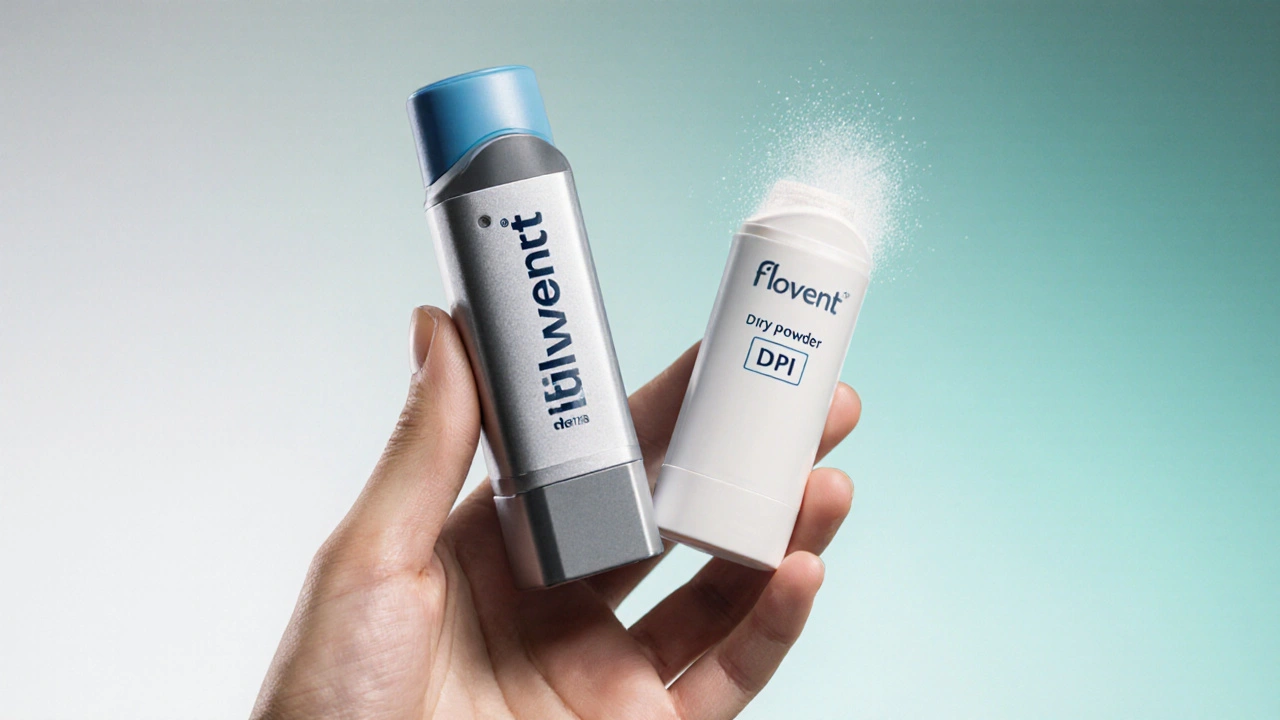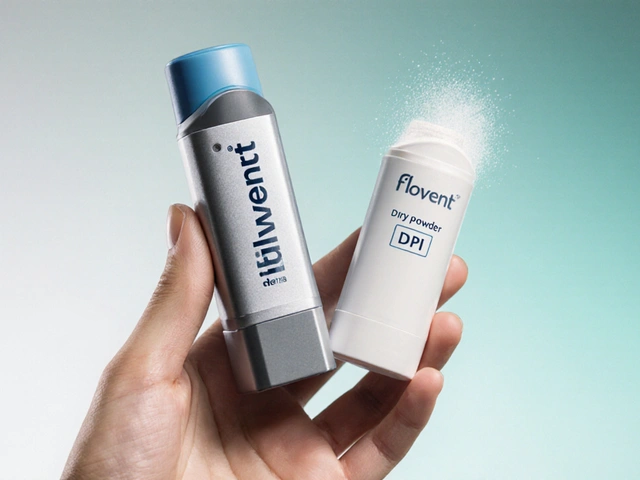Flovent vs Alternatives Comparison Tool
Flovent
Active Ingredient: Fluticasone Propionate
Dosage Range: 44–880 µg/day
Formulations: MDI, DPI
Onset: 30–60 min
Side Effects: Thrush Hoarseness Cough
Pulmicort
Active Ingredient: Budesonide
Dosage Range: 200–800 µg/day
Formulations: MDI, DPI, Nebulizer
Onset: 15–30 min
Side Effects: Oral Candidiasis Sore Throat
Asmanex
Active Ingredient: Mometasone Furoate
Dosage Range: 100–200 µg/day
Formulations: DPI
Onset: 45–60 min
Side Effects: Headache Hoarseness Thrush
Advair
Active Ingredients: Fluticasone + Salmeterol
Dosage Range: 100–500 µg fluticasone + 50–250 µg salmeterol
Formulations: MDI
Onset: 15–30 min (bronchodilator), 30–60 min (steroid)
Side Effects: Throat Irritation Tachycardia Tremor
Symbicort
Active Ingredients: Budesonide + Formoterol
Dosage Range: 200–400 µg budesonide + 6–12 µg formoterol
Formulations: MDI
Onset: Fast-acting (formoterol) within minutes
Side Effects: Oral Thrush Palpitations Jitteriness
Montelukast
Active Ingredient: Montelukast
Dosage Range: 5–10 mg/day
Formulations: Oral Tablet
Onset: 1–2 hours
Side Effects: Headache Nausea
Decision Matrix Tips
- Need Rescue Component? Combo inhalers like Advair or Symbicort offer both maintenance and quick relief.
- Propellant Sensitivity? DPI formats avoid hydrofluoroalkane propellants.
- Dosing Preference? Once-daily options simplify adherence.
- Cost Conscious? Generic budesonide or checking PHARMAC coverage can save money.
- Allergy Management? Montelukast helps with allergic rhinitis and may reduce steroid needs.
When you’re juggling asthma meds, the biggest question is often: Flovent really the best shot, or is there something smoother for my routine? Below you’ll find a straight‑to‑the‑point look at Flovent (fluticasone propionate) and the most common alternatives, so you can decide without scrolling through endless medical jargon.
What Flovent Actually Is
Flovent is a brand name for the inhaled corticosteroid fluticasone propionate used to control and prevent asthma symptoms. It works by calming airway inflammation, which means fewer wheezy attacks and a tighter grip on daily breathing comfort. The drug comes in metered‑dose inhalers (MDI) and dry‑powder inhalers (DPI), delivering doses ranging from 44µg to 220µg per puff.
Why Compare? The Jobs You Want Done
- Know how Flovent stacks up on potency and side‑effects.
- Figure out which inhaler format fits your lifestyle (MDI vs DPI).
- Spot price differences that matter for long‑term budgeting.
- Understand when a non‑steroid option might be a better fit.
- Get a quick checklist for a doctor‑visit conversation.
Top Alternatives at a Glance
Here’s a quick roll‑call of the most prescribed inhaled corticosteroids and a popular non‑steroid option. Each one appears with its own microdata tag the first time it’s mentioned.
Pulmicort is a budesonide‑based inhaler that many patients choose for its lower particle size, allowing deeper lung penetration. It’s available as both nebulizer solution and DPI.
Asmanex is the branded form of mometasone furoate, another potent inhaled corticosteroid with once‑daily dosing. Its dry‑powder format means no propellants.
Advair is a combination inhaler that blends fluticasone with the long‑acting bronchodilator salmeterol, offering both anti‑inflammation and airway relaxation. It’s a go‑to for moderate‑to‑severe asthma.
Symbicort is a duo of budesonide and formoterol, giving you a steroid plus a fast‑acting bronchodilator in one puff. Perfect for rescue‑plus‑maintenance.
Budesonide is an inhaled corticosteroid sold under many generic names, known for a good safety profile at low doses. Often prescribed for children.
Montelukast is an oral leukotriene receptor antagonist that works differently from steroids, useful for aspirin‑induced asthma or allergic rhinitis. Not an inhaler, but worth a mention as a steroid‑sparing option.

Side‑by‑Side Comparison Table
| Medication | Active Ingredient | Typical Daily Dose Range | Formulation | Onset of Action | Common Side Effects |
|---|---|---|---|---|---|
| Flovent | Fluticasone propionate | 44‑880µg (divided BID or QD) | MDI, DPI | 30‑60min | Thrush, hoarseness, cough |
| Pulmicort | Budesonide | 200‑800µg BID | MDI, DPI, nebulizer | 15‑30min | Oral candidiasis, sore throat |
| Asmanex | Mometasone furoate | 100‑200µg QD | DPI | 45‑60min | Headache, hoarseness, thrush |
| Advair | Fluticasone + Salmeterol | 100‑500µg fluticasone + 50‑250µg salmeterol BID | MDI | 15‑30min (bronchodilator), 30‑60min (steroid) | Throat irritation, tachycardia, tremor |
| Symbicort | Budesonide + Formoterol | 200‑400µg budesonide + 6‑12µg formoterol BID | MDI | Fast‑acting (formoterol) within minutes | Oral thrush, palpitations, jitteriness |
How to Pick the Right Option for You
Everyone’s asthma story is different, so the “best” inhaler isn’t a one‑size‑fits‑all. Below is a quick decision matrix you can run through before the next doctor visit.
- Do you need a rescue component? If you want a single inhaler that covers both maintenance and quick relief, combos like Advair or Symbicort make sense.
- Are you sensitive to propellants? DPI formats (e.g., Asmanex, Flovent DPI) avoid the hydrofluoroalkane propellant that can trigger irritation for some users.
- How many puffs per day can you manage? Once‑daily options (Asmanex, high‑dose Flovent DPI) simplify adherence, while twice‑daily dosing may provide finer control for severe cases.
- Cost matters? Generic budesonide (Pulmicort generic) often costs less than brand‑name fluticasone. Check your insurance formulary.
- Do you have co‑existing allergies? Adding an oral leukotriene blocker like Montelukast can cut down on nighttime symptoms without increasing inhaled steroid dose.
Managing Common Side Effects
Inhaled steroids are effective, but they can leave a sore throat or a fuzzy feeling in the mouth. Here’s how to keep the side effects at bay:
- Rinse your mouth with water and spit after every use - it cuts the risk of thrush by up to 70%.
- Use a spacer with MDIs; it reduces oropharyngeal deposition.
- Monitor your oral health. Persistent hoarseness or white patches deserve a quick check‑up.
- If you notice increased heart rate or tremor, especially with combo inhalers, talk to your doctor about adjusting the bronchodilator component.

Cost and Insurance Snapshot (2025)
Pricing varies by country and pharmacy, but here’s a rough NZ‑focused picture:
- Flovent DPI (100µg): NZ$45 for a 30‑day supply.
- Pulmicort DPI (200µg): NZ$30 generic version, often covered fully under PHARMAC.
- Asmanex DPI (100µg): NZ$55, but some health funds reimburse up to 80% for chronic asthma.
- Advair Diskus: NZ$70, generally listed as a higher‑tier drug.
- Symbicort Turbohaler: NZ$65, similar tier to Advair.
Always verify your specific plan - many insurers require step‑therapy, meaning you might need to try a cheaper generic before they approve a brand‑name.
Key Takeaways
- Flovent (fluticasone) is a solid, twice‑daily inhaled steroid with both MDI and DPI options.
- For deeper lung delivery, consider budesonide‑based Pulmicort or mometasone‑based Asmanex.
- If you need both anti‑inflammation and quick relief, combo inhalers like Advair or Symbicort may cut down the number of devices you carry.
- Cost‑sensitive patients often benefit from generic budesonide or checking PHARMAC coverage for DPI formats.
- Rinse, use spacers, and keep an eye on oral health to dodge the typical steroid side effects.
Frequently Asked Questions
Can I switch from Flovent to a generic inhaled steroid?
Yes. Budesonide (found in Pulmicort) and mometasone (Asmanex) are both FDA‑approved for asthma control. Your doctor may need to adjust the dose, but the switch can save money and may feel different in the throat.
Is a once‑daily inhaler as effective as twice‑daily?
For many moderate asthma patients, a high‑potency once‑daily inhaler like Asmanex provides comparable control. Severe cases often still need split dosing for steady blood levels.
Do combo inhalers increase the risk of side effects?
Combo inhalers add a bronchodilator, which can cause jitteriness, palpitations, or slight tremor. The steroid part retains its usual throat‑related side effects. Monitoring and possibly spacing the doses can help.
What’s the role of Montelukast compared to inhaled steroids?
Montelukast works by blocking leukotrienes, chemicals that cause airway swelling. It’s useful for patients who can’t tolerate high‑dose steroids or who have allergic rhinitis alongside asthma. It’s not a direct substitute for daily inhaled steroids.
How often should I see my doctor after changing inhalers?
Schedule a follow‑up within 4‑6 weeks of any switch. This window lets you and your clinician assess symptom control, side effects, and whether dosage tweaks are needed.






Written by Martha Elena
I'm a pharmaceutical research writer focused on drug safety and pharmacology. I support formulary and pharmacovigilance teams with literature reviews and real‑world evidence analyses. In my off-hours, I write evidence-based articles on medication use, disease management, and dietary supplements. My goal is to turn complex research into clear, practical insights for everyday readers.
All posts: Martha Elena